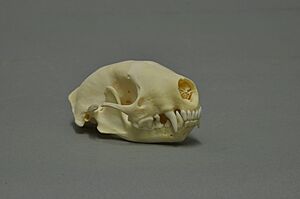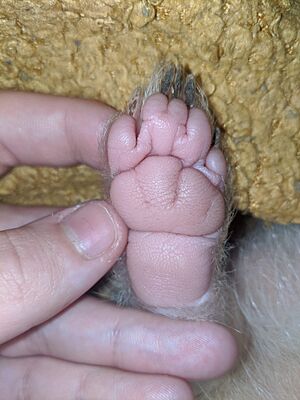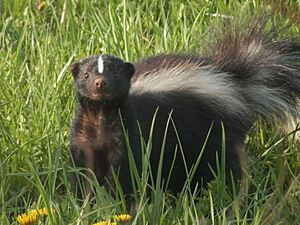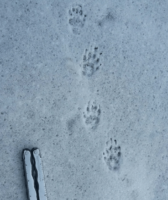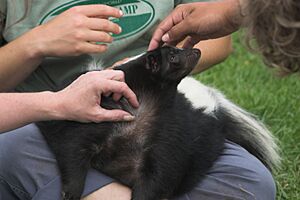Striped skunk facts for kids
Quick facts for kids Striped skunk |
|
|---|---|
 |
|
| Conservation status | |
| Scientific classification | |
| Genus: |
Mephitis
|
| Species: |
mephitis
|
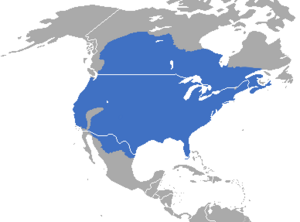 |
|
| Striped skunk range | |
| Synonyms | |
|
Viverra mephitis Schreber, 1776 |
|
The striped skunk (Mephitis mephitis) is a type of skunk found across much of North America. This includes southern Canada, the United States, and northern Mexico. It is currently listed as "least concern" by the IUCN. This means it is not in danger of disappearing. It can live in many different places, even those changed by humans.
Striped skunks are animals that mate with more than one partner. They eat both plants and other animals. They have few natural enemies, mostly large birds of prey. Like all skunks, they have special scent glands. These glands produce a strong-smelling musk to scare off predators. People have had a long connection with skunks. They have been trapped for their fur and kept as pets. The striped skunk is one of the most famous animals in North America. It often appears in cartoons and children's books.
Contents
Skunk Names and History
The striped skunk was first officially named by Johann Christian Daniel von Schreber. He called it Viverra mephitis. This first description came from eastern Canada.
What's in a Name?
The English word skunk comes from Native American languages. It comes from words like seganku (Abenaki) and scangaresse (Huron). The Cree and Ojibwe word shee-gawk is the root for Chicago. This means 'skunk-land'.
Other English names for the striped skunk include common skunk or northern skunk. Early English settlers sometimes called it a "prairie polecat." This was because it looked a bit like the European polecat. This led to the skunk getting a bad reputation for stealing chickens. However, skunks are usually less harmful than real polecats. In the late 1800s, fur traders called skunk fur "Alaska sable."
Native American Names for Skunks
Many Native American groups have their own names for the striped skunk.
| Language Group | Native Name |
|---|---|
| Abenaki | seganku |
| Chipewyan | nool'-tsee-a |
| Cree Ojibwe |
shee-gawk |
| Tŝilhqot’in (Chilcotin) | guli |
| Huron | scangaresse |
| Ogallala Sioux | mah-kah |
| Yankton Sioux | mah-cah |
Skunk Appearance
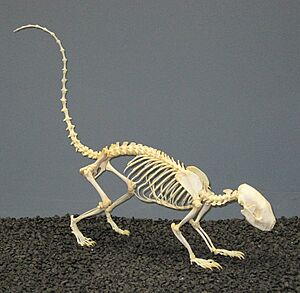
The striped skunk is a strong animal with short legs. It has a small, cone-shaped head and a long, furry tail. Adult males are about 10% larger than females. Both sexes are usually between 52 to 77 centimeters (20 to 30 inches) long. They typically weigh 1.8 to 4.5 kilograms (4 to 10 pounds). Some skunks can weigh up to 5.5 kg (12 lb).
Skunks walk on the soles of their feet, like humans. Their front feet have five long, curved claws. These claws are great for digging. The claws on their back feet are shorter and straighter.
The fur patterns can be very different. Usually, they have a black body with a white stripe. This stripe starts on the head and splits near the shoulders. It then runs along their sides to their rump and tail. Some skunks have a white patch on their chest. Others have white stripes on their front legs. Sometimes, skunks can be brown or cream-colored.
Skunk Spray: A Powerful Defense
Like all skunks, the striped skunk has two special scent glands. These are located on each side of its rear end. Each gland holds about 15 milliliters of musk. This musk is a strong chemical defense against predators. The musk is oily and yellow. It is made of very smelly chemicals called thiols. Skunks can spray this musk several meters away.
The smell of skunk musk is very strong. Some people have described it as a mix of perfume musk, garlic, burning sulfur, and sewer gas. If the spray gets into the eyes, it can cause a temporary burning feeling.
Skunk Life Cycle
Reproduction and Development
The striped skunk mates with more than one partner. It usually breeds once a year. The mating season is typically from mid-February to mid-April. In colder places, it might be later. During this time, males travel far to find females. They can cover 4 kilometers (2.5 miles) in one night.
One male skunk might have several females that he mates with. He will protect them from other males for about 35 days. After mating, the females stay in their dens. The males try to build up their fat reserves again.
The gestation period (how long they are pregnant) lasts about 59 to 77 days. Kits (baby skunks) are born around mid-May to early June. A litter usually has 2 to 12 kits. The average is five or six. One litter in Pennsylvania had 18 kits! Kits are born blind and with little fur. They weigh about 25 to 40 grams (0.9 to 1.4 ounces).
Their eyes open after about three weeks. They stop drinking milk after 42 to 56 days. Even though their musk is not fully developed yet, young kits will still try to spray when scared. At this age, kits might go outside the den with their mother. They become independent after about 2½ months.
Denning and Sheltering
Striped skunks can dig their own dens. But they will also use dens left by other animals if they find them. They usually use these dens in late fall, winter, and early spring. Females with young kits use dens in late spring and summer. In farm areas, skunks often dig dens near fences. This is because they are less likely to be disturbed there.
In winter, it's common for several female skunks and one male to share a den. During this time, skunks save energy. They lower their body temperature from 38 °C (100 °F) to 32 °C (90 °F). They might look for food for short times in winter. But they mostly rely on their stored fat. They can lose up to half their body weight in cold weather.
Skunk Ecology
Skunk Habitat
The striped skunk lives in many different places. It likes mixed woodlands, bushy areas, and open fields. These areas often have wooded ravines and rocky spots. Some skunks, especially in Illinois, prefer farm areas over wild ones.
What Skunks Eat
Striped skunks mostly eat insects. But they can also eat other animals and plants. The insects they eat most often include grasshoppers, beetles, crickets, and caterpillars. They also eat worms, crayfish, and other small creatures. In winter and spring, skunks add small animals to their diet. These include white-footed mice, voles, eggs, and baby birds. Skunks also eat amphibians, reptiles, dead animals, and fish. Skunks living near the coast in California eat crabs and fish found on the beach.
Skunks are not built for chasing fast prey. But one skunk was seen chasing rabbits into their burrows. Skunks also eat plants like apples, blueberries, black cherries, corn, and nightshade when they are in season.
Striped skunks use their sharp claws to tear apart rotting logs. They do this to find grubs. They also dig in the soil for insects. Their digging leaves small pits in the ground. These pits can show that skunks are in the area.
Who Hunts Skunks?
Because of its strong defense, the striped skunk has few natural enemies. Most mammal predators avoid skunks. They only hunt them if they are very hungry. These predators include cougars, coyotes, bobcats, badgers, and red and gray foxes.
Birds that hunt, like golden and bald eagles, and great horned owls, are better at catching skunks. But even they risk getting sprayed and blinded by the skunk's musk.
Skunk Diseases
The striped skunk is a main carrier of the rabies virus. In the US, skunks are involved in 25% of rabies cases each year. They are the main hosts in the central US and Canada. Rabies cases in skunks often happen in outbreaks. Skunks can also carry the canine parvovirus and leptospirosis. A skunk in Texas was found to have an intestinal worm called Pachysentis canicola.
Skunks and People
Skunks in Culture
The striped skunk often appears in the stories and traditions of Native Americans. Some stories explain its stripes or how it got its smell. Skunks can be heroes, villains, tricksters, or monsters in these legends. For the Muscogee people, the skunk meant family loyalty and protecting loved ones. The Winnebago people used the skunk to show vanity. This meant being beautiful outside but ugly inside.
The striped skunk was once called the "emblem of America." It is common in modern popular culture. It has been in jazz and funk songs. The word "funk" can mean a strong smell, which might be why skunks are linked to these music styles. The song "Dead Skunk" was popular in the 1970s. Skunks are also popular characters in children's stories and cartoons. Famous ones include Pepé Le Pew from Warner Bros. and Flower from Disney's Bambi. Their musky smell often makes them feared or avoided in these stories.
Trapping Skunks for Fur
The striped skunk is one of North America's most hunted fur animals. It was once the second most caught animal after the muskrat. Skunk fur is valuable because it is strong and shiny. However, this shine fades with wear and sunlight. Skunk pelts (skins) are sorted into four grades. The most valuable ones are mostly black. The value also depends on where they come from. Skunks from northern areas have finer, darker fur, which is more valuable. Skunks are easy to trap. They even go back into traps they were caught in before.
Raising skunks on farms started in the late 1890s. At that time, there was a high demand for their skins overseas. Also, too much trapping had reduced the number of valuable black skunks. Raising skunks in captivity was easier than raising mink or marten. Skunks are easier to tame and do not need special food. Farmers focused on breeding the tamest and darkest skunks. Before World War I, skunk pelts were mostly sent to Europe. Later, better ways to remove the smell and process the skins led to more interest in selling them in North America. Even though skunks were easy to breed, farming them was not very profitable. The low price of the pelts did not cover the costs of raising them. Still, raising skunks was seen as good practice for new fur farmers. It helped them learn before moving on to more valuable animals like mink or foxes.
Taming Skunks as Pets
The striped skunk is easy to tame. In the 1800s, people often kept them in barns to kill rats and mice. Through special breeding, skunks now come in many different colors. These include black, chocolate-brown, smokey gray and white, apricot, albino, white, lavender, champagne, and mahogany.
Other Uses for Skunks
Trappers and Native Americans regularly ate striped skunks. They would eat them if the animal was not too old or had not sprayed before being killed. Chinese immigrants valued the meat. They also bought skunk gall bladders for medicine.
Skunk fat was once thought to be a very good lubricant. The musk was also used as a folk remedy for asthma, despite its very strong smell.
Images for kids



